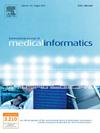Electrocardiographic-Driven artificial intelligence Model: A new approach to predicting One-Year mortality in heart failure with reduced ejection fraction patients
IF 3.7
2区 医学
Q2 COMPUTER SCIENCE, INFORMATION SYSTEMS
International Journal of Medical Informatics
Pub Date : 2025-02-19
DOI:10.1016/j.ijmedinf.2025.105843
引用次数: 0
Abstract
Background
Despite the proliferation of heart failure (HF) mortality prediction models, their practical utility is limited. Addressing this, we utilized a significant dataset to develop and validate a deep learning artificial intelligence (AI) model for predicting one-year mortality in heart failure with reduced ejection fraction (HFrEF) patients. The study’s focus was to assess the effectiveness of an AI algorithm, trained on an extensive collection of ECG data, in predicting one-year mortality in HFrEF patients.
Methods
We selected HFrEF patients who had high-quality baseline ECGs from two hospital visits between September 2016 and May 2021. A total of 3,894 HFrEF patients (64% male, mean age 64.3, mean ejection fraction 29.8%) were included. Using this ECG data, we developed a deep learning model and evaluated its performance using the area under the receiver operating characteristic curve (AUROC).
Results
The model, validated against 16,228 independent ECGs from the original cohort, achieved an AUROC of 0.826 (95 % CI, 0.794–0.859). It displayed a high sensitivity of 99.0 %, positive predictive value of 16.6 %, and negative predictive value of 98.4 %. Importantly, the deep learning algorithm emerged as an independent predictor of 1-yr mortality of HFrEF patients with an adjusted hazards ratio of 4.12 (95 % CI 2.32–7.33, p < 0.001).
Conclusions
The depth and quality of our dataset and our AI-driven ECG analysis model significantly enhance the prediction of one-year mortality in HFrEF patients. This promises a more personalized, future-focused approach in HF patient management.

心电图驱动的人工智能模型:预测心力衰竭伴射血分数降低患者一年死亡率的新方法
背景:尽管心衰(HF)死亡率预测模型越来越多,但其实际应用仍然有限。为了解决这个问题,我们利用一个重要的数据集来开发和验证一个深度学习人工智能(AI)模型,用于预测心力衰竭患者的一年死亡率。该研究的重点是评估人工智能算法在预测HFrEF患者一年内死亡率方面的有效性,该算法经过大量ECG数据的训练。方法:我们选择了2016年9月至2021年5月期间两次医院就诊的高质量基线心电图HFrEF患者。共纳入3894例HFrEF患者(男性64%,平均年龄64.3岁,平均射血分数29.8%)。利用这些ECG数据,我们开发了一个深度学习模型,并使用接收者工作特征曲线下面积(AUROC)评估其性能。结果该模型通过原始队列的16,228个独立心电图验证,AUROC为0.826 (95% CI, 0.794-0.859)。其敏感性为99.0%,阳性预测值为16.6%,阴性预测值为98.4%。重要的是,深度学习算法成为HFrEF患者1年死亡率的独立预测因子,调整后的风险比为4.12 (95% CI 2.32-7.33, p <;0.001)。我们的数据集的深度和质量以及我们的人工智能驱动的心电图分析模型显著提高了对HFrEF患者一年死亡率的预测。这为心衰患者管理提供了一种更加个性化、着眼于未来的方法。
本文章由计算机程序翻译,如有差异,请以英文原文为准。
求助全文
约1分钟内获得全文
求助全文
来源期刊

International Journal of Medical Informatics
医学-计算机:信息系统
CiteScore
8.90
自引率
4.10%
发文量
217
审稿时长
42 days
期刊介绍:
International Journal of Medical Informatics provides an international medium for dissemination of original results and interpretative reviews concerning the field of medical informatics. The Journal emphasizes the evaluation of systems in healthcare settings.
The scope of journal covers:
Information systems, including national or international registration systems, hospital information systems, departmental and/or physician''s office systems, document handling systems, electronic medical record systems, standardization, systems integration etc.;
Computer-aided medical decision support systems using heuristic, algorithmic and/or statistical methods as exemplified in decision theory, protocol development, artificial intelligence, etc.
Educational computer based programs pertaining to medical informatics or medicine in general;
Organizational, economic, social, clinical impact, ethical and cost-benefit aspects of IT applications in health care.
 求助内容:
求助内容: 应助结果提醒方式:
应助结果提醒方式:


